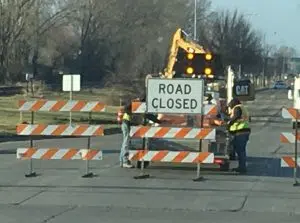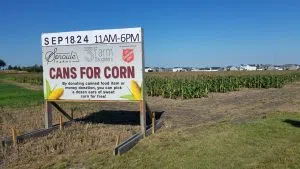
Kodi Pinks, director of Non-Infectious Disease Surveillance and Data Management for the North Dakota Department of Health and Human Services, presents data on unintentional overdose deaths to lawmakers on the Health Services Committee on Sept. 16, 2024. (Mary Steurer/North Dakota Monitor)
(North Dakota Monitor) -Unintentional drug overdose deaths in North Dakota have increased since 2019 but fell last year, according to preliminary data from the state Department of Health and Human Services.
Between 2019 and 2023, overdose deaths rose roughly 48%. That figure peaked at 135 deaths in 2022, then fell to 113 deaths 2023.
Fentanyl-related deaths are increasing. In 2019, 42% of deaths tested positive for fentanyl, while in 2023, that number was 77%.
“Behind this data are actual people,” said Kodi Pinks, the agency’s director of Non-Infectious Disease Surveillance and Data Management, told state lawmakers Monday during a Health Services Committee meeting. “I know that behind these numbers are families and communities that have been directly impacted by these losses.”

Overdose deaths are expected to hold steady in 2024 — between January and the end of July, there have been 54. That number isn’t final though, Pinks said.
“A lot of toxicology results are still pending for 2024,” she said.
Roughly two-thirds of overdose deaths were male. Most victims were also under age 39, according to the Department of Health and Human Services.
About three-quarters of all deaths took place at a residence, like a home or apartment, and around 30% of those who died also tested positive for alcohol.
Native American overdose deaths exceeded those of other racial demographics, the agency found. Between 2019 and 2023, the overdose death rate for Native Americans was roughly 8.48 per 10,000 people. By comparison, the rate for white people was 1.14 per 10,000 people.
The data reflect all known unintentional overdose deaths that occurred in North Dakota; it’s not limited to just North Dakota residents.

Deaths were most frequent in Mountrail, Sioux and Benson counties. The rates of unintentional overdose deaths in those counties are more than double the state average.
The agency has also recorded 13 deaths since 2019 involving xylazine, a non-opioid tranquilizer, combined with fentanyl.
Laura Anderson, policy director for the Health and Human Services Department’s Behavioral Health Division, also shared how the state is using some of its money from opioid lawsuit settlements.
North Dakota is one of thousands of plaintiffs involved in lawsuits against pharmaceutical companies related to the false marketing and overprescription of opiates.
Health and Human Services awarded about $7 million in grant money earlier this year to 14 organizations providing services like addiction treatment and prevention, and job training for medical professionals.
More than 60 organizations applied for the grant, requesting almost $60 million in funding, Anderson said.
Grand Forks and Richland counties were awarded grant money for treatment courts, which have served 13 people since the beginning of the year.
Another grant recipient was North Dakota State University’s Opioid Naloxone Education program. The program has installed boxes of naloxone, an overdose-reversing drug, all across North Dakota, Anderson said.
Workforce was also a key focus of the grant. The grant has helped fund six new training locations for addiction counselors, which includes paid internships for 18 trainees. Eight people have graduated with behavioral health licenses so far, Anderson said.
Unintentional drug overdose deaths in North Dakota have increased since 2019 but fell last year, according to preliminary data from the state Department of Health and Human Services.
Between 2019 and 2023, overdose deaths rose roughly 48%. That figure peaked at 135 deaths in 2022, then fell to 113 deaths 2023.
Fentanyl-related deaths are increasing. In 2019, 42% of deaths tested positive for fentanyl, while in 2023, that number was 77%.
“Behind this data are actual people,” said Kodi Pinks, the agency’s director of Non-Infectious Disease Surveillance and Data Management, told state lawmakers Monday during a Health Services Committee meeting. “I know that behind these numbers are families and communities that have been directly impacted by these losses.”

Overdose deaths are expected to hold steady in 2024 — between January and the end of July, there have been 54. That number isn’t final though, Pinks said.
“A lot of toxicology results are still pending for 2024,” she said.
Roughly two-thirds of overdose deaths were male. Most victims were also under age 39, according to the Department of Health and Human Services.
About three-quarters of all deaths took place at a residence, like a home or apartment, and around 30% of those who died also tested positive for alcohol.
Native American overdose deaths exceeded those of other racial demographics, the agency found. Between 2019 and 2023, the overdose death rate for Native Americans was roughly 8.48 per 10,000 people. By comparison, the rate for white people was 1.14 per 10,000 people.
The data reflect all known unintentional overdose deaths that occurred in North Dakota; it’s not limited to just North Dakota residents.

Deaths were most frequent in Mountrail, Sioux and Benson counties. The rates of unintentional overdose deaths in those counties are more than double the state average.
The agency has also recorded 13 deaths since 2019 involving xylazine, a non-opioid tranquilizer, combined with fentanyl.
Laura Anderson, policy director for the Health and Human Services Department’s Behavioral Health Division, also shared how the state is using some of its money from opioid lawsuit settlements.
North Dakota is one of thousands of plaintiffs involved in lawsuits against pharmaceutical companies related to the false marketing and overprescription of opiates.
Health and Human Services awarded about $7 million in grant money earlier this year to 14 organizations providing services like addiction treatment and prevention, and job training for medical professionals.
More than 60 organizations applied for the grant, requesting almost $60 million in funding, Anderson said.
Grand Forks and Richland counties were awarded grant money for treatment courts, which have served 13 people since the beginning of the year.
Another grant recipient was North Dakota State University’s Opioid Naloxone Education program. The program has installed boxes of naloxone, an overdose-reversing drug, all across North Dakota, Anderson said.
Workforce was also a key focus of the grant. The grant has helped fund six new training locations for addiction counselors, which includes paid internships for 18 trainees. Eight people have graduated with behavioral health licenses so far, Anderson said.









